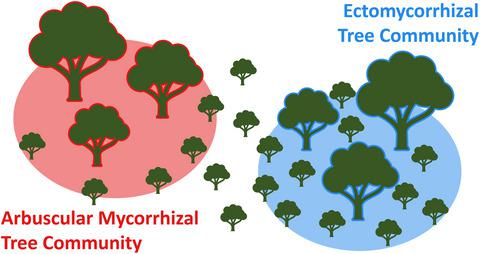当前位置:
X-MOL 学术
›
Funct. Ecol.
›
论文详情
Our official English website, www.x-mol.net, welcomes your
feedback! (Note: you will need to create a separate account there.)
Dominant community mycorrhizal types influence local spatial structure between adult and juvenile temperate forest tree communities
Functional Ecology ( IF 4.6 ) Pub Date : 2020-09-07 , DOI: 10.1111/1365-2435.13674 Andrew C. Eagar 1 , Colleen R. Cosgrove 1 , Mark W. Kershner 1 , Christopher B. Blackwood 1
中文翻译:

优势群落菌根类型影响成年和幼年温带林木群落的局部空间结构
更新日期:2020-09-07
Functional Ecology ( IF 4.6 ) Pub Date : 2020-09-07 , DOI: 10.1111/1365-2435.13674 Andrew C. Eagar 1 , Colleen R. Cosgrove 1 , Mark W. Kershner 1 , Christopher B. Blackwood 1
Affiliation

|
- Plant–soil feedback (PSF) is known to influence plant community composition, and recent work suggests that these effects may be regulated by traits related to mycorrhizal associations and phylogenetic relationships. However, there is a critical need to test the usefulness of these traits in predicting PSF outcomes in natural plant communities.
- To test for evidence of mycorrhizal and phylogenetic controls over PSF at both the species and community level, we examined the spatial relationship between adult and juvenile trees in stem‐mapped hardwood forest plots using point pattern analyses and linear mixed‐effect models.
- We found that spatial patterns of adult and juvenile trees, as well as overall adult tree recruitment, were significantly affected by the dominant mycorrhizal type of our forested communities, but were not influenced by the phylogenetic relationship between adult and juvenile trees. Additionally, PSF experienced by individual species was dependent on the mycorrhizal dominance of the surrounding community.
- Spatial patterns in communities dominated by arbuscular mycorrhizal trees reflected overdispersion between adult and juvenile trees (suggestive of negative PSF), while communities dominated by ectomycorrhizal trees reflected clustering (suggestive of positive PSF).
- Our findings indicate that PSFs are driven by the mycorrhizal associations of dominant trees, with effects of dominant community member traits on soil microorganisms and biogeochemistry ‘spilling over’ onto less abundant individuals in the community. Our research supports the use of whole‐community, mycorrhizal‐based frameworks for studying PSF in plant communities where multiple mycorrhizal types are present.
中文翻译:

优势群落菌根类型影响成年和幼年温带林木群落的局部空间结构
- 已知植物-土壤反馈(PSF)影响植物群落组成,最近的研究表明,这些作用可能受与菌根协会和系统发育关系相关的性状调节。但是,迫切需要测试这些性状在预测天然植物群落中PSF结果方面的有用性。
- 为了在物种和群落水平上测试对PSF的菌根和系统发育控制的证据,我们使用点模式分析和线性混合效应模型检查了茎映射硬木林地中成年树和幼树之间的空间关系。
- 我们发现,成年树和幼树的空间格局以及成年树的整体募集受到我们森林社区的主要菌根类型的显着影响,但不受成年树和幼树之间的系统发育关系的影响。此外,个别物种经历的PSF取决于周围社区的菌根优势。
- 以丛枝菌根树为主的社区的空间格局反映了成年树和幼树之间的过度分散(建议为阴性PSF),而由外生菌根树为主的社区则反映了集群(建议为PSF阳性)。
- 我们的发现表明,PSF受优势树的菌根协会驱动,具有优势的社区成员性状对土壤微生物和生物地球化学“溢出”到社区中较不丰富的个体的影响。我们的研究支持在存在多种菌根类型的植物群落中使用基于菌根的全社区框架研究PSF。











































 京公网安备 11010802027423号
京公网安备 11010802027423号